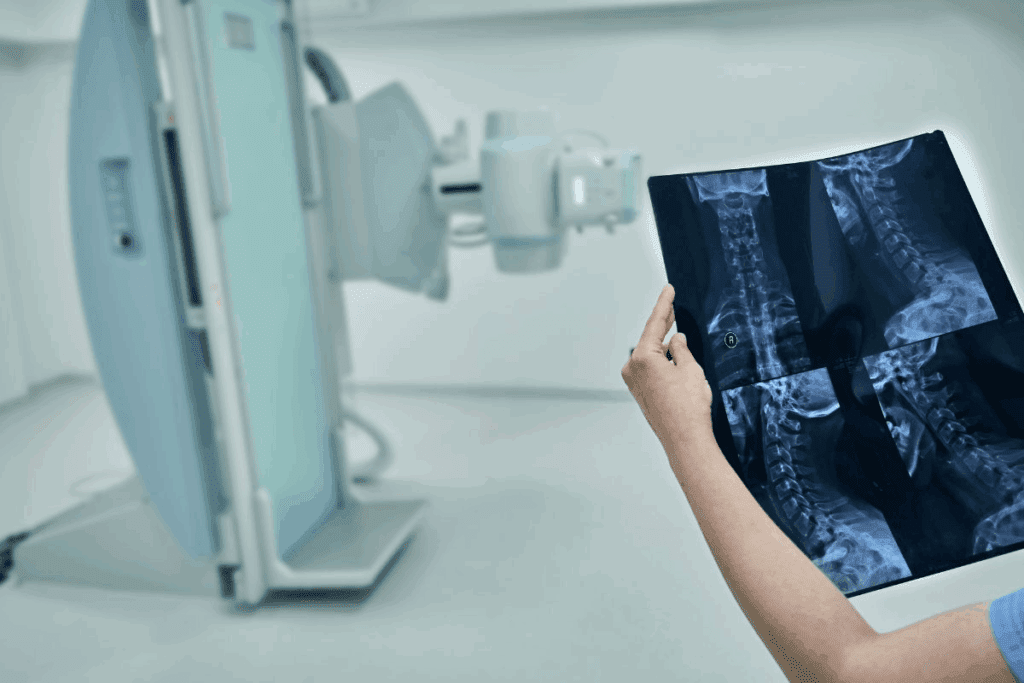Last Updated on November 26, 2025 by Bilal Hasdemir

Many people ask about the VIR medical term and its role in vascular interventional procedures. VIR stands for Vascular Interventional Radiology, a specialized field within interventional radiology that has revolutionized how doctors diagnose and treat vascular conditions.
Vascular Interventional Radiology (VIR) uses advanced imaging techniques such as X-rays, CT scans, and ultrasounds to perform minimally invasive treatments. These procedures help patients recover faster, reduce risks compared to traditional surgery, and achieve better outcomes.
At Liv Hospital, we focus on delivering world-class care using the latest VIR techniques. Our international patient services ensure that patients from around the globe receive cutting-edge vascular treatments with precision, safety, and comfort. Understanding the VIR medical term helps patients appreciate the value and innovation behind these life-changing procedures.
Key Takeaways
- IR stands for Interventional Radiology, a field that uses advanced imaging for minimally invasive treatments.
- Interventional Radiology has transformed the diagnosis and treatment of various medical conditions.
- IR reduces recovery times and improves patient outcomes by minimizing invasion.
- Liv Hospital is dedicated to providing comprehensive care using IR and other advanced treatments.
- Our team of experts is committed to delivering world-class healthcare with international patient support.
Decoding the VIR Medical Term in Healthcare

The VIR medical term is key in vascular interventional radiology. It’s used in medical records and notes. It helps doctors talk about this specialty.
Historical Development of Interventional Radiology
Interventional radiology has grown a lot over time. It started simple and now does complex procedures. New imaging and techniques have made it a critical tool in medicine.
Key Milestones in IR Development:
| Year | Milestone | Impact |
| 1960s | Introduction of Angiography | Enabled visualization of blood vessels |
| 1980s | Development of Embolization Techniques | Allowed for minimally invasive treatment of vascular conditions |
| 2000s | Advancements in Imaging Modalities | Improved precision and safety in IR procedures |
The Distinction Between Diagnostic and Interventional Radiology
Digital radiology uses images to find diseases. But, interventional radiology uses images to guide treatments. It’s all about how they’re used.
The VIR term is linked to vascular interventional radiology. Knowing this term helps everyone understand IR’s role in medicine.
What Does IR Mean in Medical Terms: Full Form and Definition

Interventional Radiology, or ‘IR,’ is a key part of today’s healthcare. Knowing what IR means is very important. It has grown a lot, becoming a big part of how we diagnose and treat diseases.
The Complete Meaning of IR Medical Abbreviation
The full form of ‘IR’ is Interventional Radiology. This field uses special procedures to find and treat diseases. It’s a mix of radiology and surgery, but less invasive than old surgeries.
IR doctors do many procedures, like angiography and biopsy. They use X-rays and MRI to guide their work.
How IR Appears in Medical Documentation
IR is seen a lot in medical records. It helps doctors talk clearly and quickly. It’s used in hospitals everywhere.
In records, IR procedures are detailed. For instance, a patient’s file might show an angiography report.
| Procedure | Description | Imaging Guidance |
| Angiography | Imaging of blood vessels | X-ray |
| Angioplasty | Balloon dilation of narrowed vessels | X-ray |
| Embolization | Blocking blood flow to a specific area | X-ray, MRI |
Knowing about IR is key for doctors and patients. It helps in clear talks, right diagnoses, and good treatment plans. As IR grows, it will bring new ways to treat diseases.
The Specialized Role of an IR Doctor in Patient Care
IR doctors play a key role in patient care. They use both diagnostic and interventional techniques. This helps improve patient outcomes.
Educational Pathway and Certification Requirements
To become an IR doctor, one must go through tough training. They need to complete a residency in radiology and a fellowship in interventional radiology. Getting certified by the American Board of Radiology is also a must.
The education for IR doctors prepares them for complex procedures. It includes:
- Completing medical school
- Residency in diagnostic radiology
- Fellowship training in interventional radiology
- Board certification
Clinical Expertise and Procedural Skills
IR doctors have advanced skills for performing minimally invasive procedures. These include:
- Angiography and angioplasty
- Embolization procedures
- Vascular stenting and thrombectomy
The Society of Interventional Radiology says IR has changed how we treat many conditions. It offers patients less invasive options than traditional surgery. This highlights the critical role of IR doctors in healthcare.
Collaboration with Other Medical Specialists
IR doctors work with other specialists to give patients the best care. This teamwork is key for:
- Creating treatment plans
- Coordinating care
- Enhancing patient outcomes
As medical technology advances, IR doctors will keep playing a vital role. Their skills and teamwork with other specialists ensure patients get the best treatments.
Fundamental Techniques in Interventional Radiology
Interventional Radiology (IR) uses key techniques for precise treatments. It tackles many issues, like blockages, tumors, and organ problems. It also helps in delivering drugs directly to the right place. This field has changed patient care by providing less invasive options instead of surgery.
Imaging Modalities Used in IR Procedures
IR relies on advanced imaging to guide treatments. The main imaging tools are:
- X-rays: Show real-time images during procedures like angiography and angioplasty.
- CT scans: Give detailed images for precise needle placement and tumor treatment.
- Ultrasounds: Help see blood flow and guide biopsies and drainages.
These tools are vital for IR’s success, helping in accurate diagnosis and treatment.
Minimally Invasive Approaches and Their Advantages
IR’s minimally invasive nature offers many benefits. These include:
- Reduced recovery time: Patients can get back to normal activities faster than with surgery.
- Less pain and discomfort: Smaller cuts mean less damage and pain.
- Lower risk of complications: IR procedures usually have fewer side effects than surgery.
These points make IR a good choice for many patients.
Tools and Equipment Specific to IR
The success of IR depends on its specialized tools and equipment. Some key ones are:
- Catheters and guidewires: Help navigate through blood vessels to the target area.
- Stents and balloons: Used in angioplasty to open blocked arteries.
- Embolic agents: Block blood flow to areas like tumors for treatment.
These tools, along with advanced imaging, allow IR specialists to perform complex tasks with great precision.
Vascular Interventional Radiology: Core Procedures and Applications
Vascular IR procedures are key in treating many vascular diseases. They offer safer options than traditional surgery. In Oregon, these centers lead in vascular and non-vascular treatments.
Angiography and Angioplasty Techniques
Angiography is a vital tool in vascular IR. It lets doctors see blood vessels clearly. They use it to spot blockages and other issues.
Angioplasty is often done with angiography. A balloon is used to open up narrowed or blocked vessels. This helps blood flow normally again.
Key Steps in Angioplasty:
- Accessing the affected vessel through a small incision
- Using imaging guidance to navigate to the blockage
- Inflating a balloon to widen the vessel
- Placing a stent to maintain vessel patency
Embolization Procedures for Various Conditions
Embolization is a key procedure in vascular IR. It’s used to treat bleeding, tumors, and vascular malformations. By blocking blood flow, it helps control symptoms and improve outcomes.
| Condition | Embolization Technique | Benefits |
| Bleeding | Coil embolization | Controls hemorrhage |
| Tumors | Particle embolization | Reduces tumor size and symptoms |
| Vascular Malformations | Liquid embolization | Eliminates malformation |
Vascular Stenting and Thrombectomy
Vascular stenting keeps a vessel open after angioplasty. Thrombectomy removes blood clots from vessels. Both are critical in vascular IR, helping restore blood flow quickly and reduce damage.
“The advancements in vascular IR have significantly improved patient outcomes, providing minimally invasive alternatives to complex surgeries.” – Dr. John Smith, Interventional Radiologist
Vascular IR keeps evolving, treating many vascular diseases effectively. Oregon’s centers are leaders in these advancements. They drive innovation and improve patient care.
Non-Vascular IR Procedures: Expanding Treatment Options
Non-vascular interventional radiology (IR) procedures have changed how we treat many health issues. They go beyond just vascular diseases. These methods allow us to tackle different health problems in a less invasive way.
Tumor Ablation and Cancer Interventions
Tumor ablation is a key part of non-vascular IR. It uses imaging to kill cancer tumors without surgery. We use radiofrequency ablation (RFA) and microwave ablation (MWA) to heat tumors, killing cancer cells. This is great for patients who can’t have surgery or have few other options.
Chemoembolization is another cancer treatment. It delivers chemotherapy directly to the tumor while cutting off its blood supply. This combo reduces tumor size and improves patient results.
Biliary and Urinary Tract Procedures
Non-vascular IR also helps with biliary and urinary tract issues. For example, percutaneous transhepatic cholangiography (PTC) and biliary drainage fix bile duct blockages. They help restore bile flow, easing symptoms like jaundice and itching.
In the urinary tract, procedures like percutaneous nephrostomy (PCN) help with urinary blockages. They create a direct urine drainage path, preventing infections and kidney damage.
Musculoskeletal Applications
Musculoskeletal interventions are also a big part of non-vascular IR. Vertebroplasty and kyphoplasty stabilize fractured vertebrae, reducing pain and improving mobility in osteoporotic patients.
We also do joint injections and biopsies using IR techniques. For example, ultrasound-guided corticosteroid injections can ease pain and inflammation in arthritic joints.
The table below shows some key non-vascular IR procedures and their uses:
| Procedure | Application | Benefits |
| Tumor Ablation | Cancer treatment | Minimally invasive, preserves organ function |
| Biliary Drainage | Bile duct obstruction | Restores bile flow, alleviates symptoms |
| Percutaneous Nephrostomy | Urinary obstruction | Provides urine drainage, prevents complications |
| Vertebroplasty/Kyphoplasty | Osteoporotic compression fractures | Stabilizes vertebrae, reduces pain |
These non-vascular IR procedures show how versatile and effective IR is in treating many health issues. By improving these techniques, we can better care for patients and enhance their outcomes.
Oregon Interventional Radiology Centers: Excellence in IR Practice
Oregon is home to top-notch interventional radiology centers. They offer the best care in vascular and non-vascular treatments. These centers lead in interventional radiology (IR), with innovative treatments that boost patient results.
Advanced Treatment Options Available in Oregon
Oregon’s IR centers have the latest tech. They provide a wide range of treatments. This includes vascular procedures like angiography and angioplasty and non-vascular interventions like tumor ablation.
Patients get access to modern, minimally invasive treatments. This cuts down recovery time and boosts results. The centers keep up with IR’s latest to give patients top care.
Patient Outcomes and Success Stories
Oregon’s IR centers show their excellence in patient results and stories. Many patients see big improvements in their lives thanks to these treatments.
“The care I received at the interventional radiology center in Oregon was exceptional. The team was professional, compassionate, and highly skilled.” –
A satisfied patient
These stories show the centers’ focus on quality care and patient happiness.
Research and Innovation Contributions
Oregon’s IR centers are not just treatment leaders. They also play a big role in IR research and innovation. They work with other places to improve IR understanding and use.
- Participation in clinical trials for new IR procedures
- Development of novel techniques and technologies
- Publication of research findings in prestigious medical journals
These efforts show the centers’ impact on IR’s future, both locally and worldwide.
The IR Patient Journey: From Diagnosis to Recovery
For patients going through interventional radiology (IR) procedures, the path from diagnosis to recovery is complex and personal. We aim to offer full support and guidance at every step. This helps make the journey easier to navigate.
Initial Consultation and Procedure Planning
The journey starts with an initial consultation. Here, our team works closely with the patient to understand their condition and find the best treatment plan. This stage is key in addressing the patient’s specific needs and preparing them for the procedure.
During this consultation, we review the patient’s medical history and condition. We also discuss the available treatment options. This helps us tailor the treatment plan to meet the patient’s unique needs.
The IR Suite Experience
The IR suite experience is a vital part of the journey. Our facilities are designed for comfort and safety, allowing our clinicians to perform procedures with precision.
We use advanced imaging technologies to guide our interventions. This ensures accurate and effective treatment. Our team is committed to providing a supportive and reassuring environment during the procedure.
Follow-up Care and Long-term Outcomes
After the procedure, we provide detailed follow-up care to monitor the patient’s recovery. We address any concerns they may have. This ongoing support is key to ensuring the best outcomes and a smooth recovery.
We track patient outcomes over time to refine our treatment approaches. Our goal is to deliver exceptional patient care throughout the entire journey.
| Stage | Description | Key Elements |
| Initial Consultation | Understanding the patient’s condition and determining the treatment plan | Medical history review, discussion of treatment options |
| IR Suite Experience | Performing the IR procedure with precision and care | Advanced imaging technologies, patient comfort and safety |
| Follow-up Care | Monitoring recovery and addressing patient concerns | Ongoing support, outcome tracking, quality improvement |
Throughout the IR patient journey, we are dedicated to providing personalized, compassionate care. We understand the complexities of IR procedures and the importance of full support. This allows us to deliver exceptional treatment outcomes and improve the patient experience.
As we advance in interventional radiology, our focus is on enhancing patient care. We aim to expand treatment options for a wide range of medical conditions.
IR Medical Abbreviation in Clinical Communication
Healthcare professionals need to understand “IR” well to care for patients best. “IR” stands for Interventional Radiology and is key in talking about patient care. It makes sure medical records and plans are clear.
Standardized Usage in Electronic Health Records
Using the same terms in electronic health records (EHRs) is very important. We make sure “IR” always means Interventional Radiology in EHRs. This makes it easier for doctors to understand each other.
For example, using “IR” the same way helps track a patient’s treatments. This is key for giving the best care.
| Term | Abbreviation | Usage in EHR |
| Interventional Radiology | IR | Procedure notes, treatment plans, patient history |
| Diagnostic Radiology | DR | Imaging reports, diagnostic notes |
Interdepartmental Communication Protocols
Good communication between departments is vital. We use “IR” in our communication to keep everyone informed. This includes reports and team meetings.
Benefits of Standardized “IR” Abbreviation:
- Clearer communication
- Less chance of mistakes
- Better care for patients
Patient Education About IR Terminology
Telling patients about “IR” is important. We explain what “IR” means and how it affects their care. This helps patients understand their treatment better.
Knowing about “IR” helps patients get the best care. Using the same terms, talking well between departments, and teaching patients are all important. They help make sure patients get the care they need.
Advancements in Vascular IR Technology and Techniques
Vascular interventional radiology is leading in medical innovation. New technologies are improving how procedures are done. We see big steps forward in vascular IR, thanks to new imaging, materials, and hybrid rooms.
Next-Generation Imaging Systems
New imaging systems are changing vascular IR. They give clearer images, helping doctors do their jobs better. Key features include:
- Higher resolution for seeing small vessels better
- Advanced software for better image processing
- Working with other imaging types for full diagnostics
These new imaging tools are key for vascular IR success. They help doctors diagnose and treat more accurately.
Novel Embolic and Stent Materials
New materials for embolics and stents are also advancing vascular IR. These materials are better for the body, last longer, and work better. Examples include:
- Drug-eluting stents to lower restenosis risk
- Biodegradable stents that dissolve after use
- Advanced embolic materials for better control
These new materials are giving doctors more ways to treat vascular issues. This leads to better patient results and fewer problems.
Hybrid Operating Rooms and Procedural Environments
Hybrid operating rooms are a big step forward in vascular IR. These rooms mix top-notch imaging with the flexibility of a regular OR. Benefits include:
- Better workflow and efficiency for complex cases
- More safety for patients with real-time imaging
- More room for teamwork among different doctors
Hybrid rooms are raising the bar for vascular IR. They make it possible to do more complex procedures safely and with precision.
Comparing IR Interventions to Conventional Surgery
IR interventions have many benefits over traditional surgery. They lead to shorter recovery times and less pain for patients. This makes IR procedures a great option for many.
Clinical Efficacy and Safety Profiles
Research shows IR interventions work as well as, or even better than, surgery for some issues. For example, a study found IR-guided tumor ablation and traditional surgery had similar success rates. But IR had fewer complications.
IR procedures are safer because they are less invasive. This means fewer infections and other complications compared to surgery.
Recovery Time and Hospital Stay Duration
IR interventions have a big advantage: they lead to faster recovery. This is because they cause less tissue damage, resulting in less pain and quicker healing.
IR procedures also mean shorter hospital stays. This is because they are less invasive, requiring less postoperative care.
| Procedure Type | Average Recovery Time | Average Hospital Stay |
| IR Interventions | 1-3 days | 0-1 day |
| Conventional Surgery | 4-7 days | 2-5 days |
Cost-Benefit Analysis for Healthcare Systems
IR interventions are often more cost-effective. They require less postoperative care and lead to shorter hospital stays. This results in significant cost savings.
IR interventions also reduce indirect costs. For example, they reduce lost productivity due to longer recovery times from surgery. This makes them a better economic choice for healthcare systems.
Patient Selection Criteria
Choosing the right patients for IR interventions is key. We consider the patient’s health, the condition being treated, and the procedure’s risks.
We use a team approach to decide the best treatment. This ensures patients get the safest and most effective care for their needs.
Conclusion: The Growing Impact of IR in Modern Medicine
Interventional Radiology (IR) has changed medicine a lot. It offers new ways to treat patients without big surgeries. Knowing what an ir doctor meaning and their role helps us see IR’s benefits.
The vir medical term stands for Vascular and Interventional Radiology. This area has grown a lot in recent years. Using ir medical abbreviation makes talking about treatments easier and faster.
IR is growing fast in medicine. New tech will bring even more ways to help patients. This means better care and more options for treatment.
The future of IR is bright. There’s always new research to make care even better. We need to keep teaching doctors and patients about IR’s good points.
FAQ
What does ‘IR’ stand for in medical terms?
IR stands for Interventional Radiology. It’s a medical field that uses imaging to guide procedures.
What is the role of IR doctors in patient care?
IR doctors are key in patient care. They do procedures that help patients get better. They use imaging and their skills to do this.
What are the benefits of vascular IR procedures?
Vascular IR procedures are less invasive than surgery. They help patients recover faster and get better results.
What is the significance of Oregon interventional radiology centers in IR practice?
Oregon’s IR centers are leaders in the field. They offer the latest treatments and improve care with advanced procedures.
How is IR medical abbreviation used in clinical communication?
The IR medical term helps doctors talk clearly. It ensures patients get the right treatment and care.
What are the advantages of IR interventions compared to conventional surgery?
IR interventions have many benefits. They have shorter recovery times, are safer, and cost less. This makes them a good choice for many patients.
What is the full form of VIR in medical terms?
VIR stands for Vascular Interventional Radiology. It’s a part of IR that deals with vascular diseases.
How do IR doctors collaborate with other medical specialists?
IR doctors work with other specialists to care for patients. They use their skills in imaging and procedures to help patients get better.
What are the latest advancements in vascular IR technology and techniques?
New tech and techniques in vascular IR include better imaging and materials. Hybrid rooms also help improve care and outcomes.
What is the IR patient journey like?
The IR patient journey has several steps. It includes a first visit, planning, the procedure, and follow-up. The focus is on supporting and guiding the patient.






